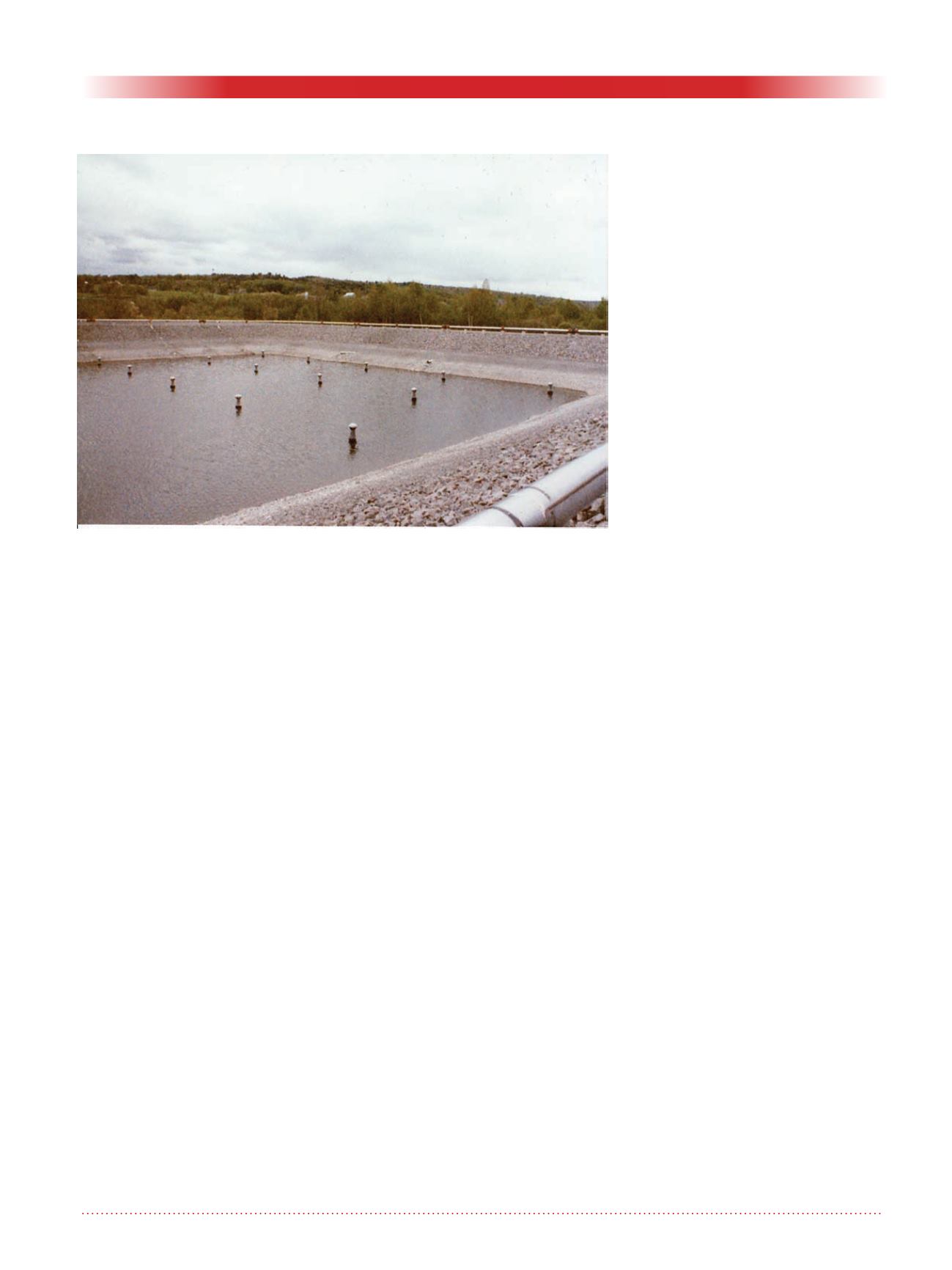
Geotechnical News • June 2016
45
GROUNDWATER
w
between 36% and 41%) below the
liquid limit,
w
L
, and a specific grav-
ity of solids,
G
s,
of 2.78. A standard
Proctor test gave an optimum,
ρ
opt
= 1587 kg/m
3
at
w
opt
= 23.8%. The
specifications required that
ρ
d
c
≥ 90%
ρ
opt
,
and
w
c
≥ 23.8%, after compaction.
There was no specification for
S
r
after
compaction,
S
rc
. The total leakage
rates had to be lower than target values
defined as a water level drop of 1 cm/d
in lagoon 1, and 2 cm/d in lagoon
2. The different values were related
to the environmental impact evalua-
tion made at the time (1980s) by the
designing engineer.
The total leakage rate of each lagoon
was measured by monitoring the
water level versus time after the
valves on influent and effluent pipes
were closed. The water levels were
measured to the nearest mm within
hydraulic structures connected to the
lagoons. This eliminated wave effects.
The levels were corrected for rain and
evaporation, using rain gauges and
evaporation pans.
None of the liners passed the test. For
lagoon No.1 at full water level, the
drop was 5 cm/d, five times higher
than required. For lagoon No.2 at full
water level, the drop was 10 cm/d, five
times higher than required. Leakage
rates were measured at different water
levels in the ponds.
Full-scale leakage test – lagoon no. 1
The water level versus time is shown
in Fig. 2a. The total flow rate is noted
Q
for a water height
h
above the top of
the bottom liner. It takes a maximum
value
Q
max
for a maximum value of
h,
h
max
.
The ratio
Q/Q
max
versus
h/h
max
is plotted in Fig. 2b. The theoretical
curves in Fig. 2b are those given by
the closed-form equations of Chapuis
(1990a), which involve two hydraulic
conductivities,
K
b
for the bottom part
and
K
s
for the sloping part of the liner.
The initial water level drop was about
5 cm/d, 5 times higher than the target
value. Figure 2b helps to identify
the nature and location of hydraulic
defects. The field results (Fig. 2) could
have three explanations:
1. The liner could have been fissured
when the water level exceeded a
certain elevation. This can occur
if the liner rests on a low bearing
capacity soil: the large uneven
settlement creates fissures in the
liner. The cracks stay opened when
h/h
max
exceeds a certain value,
but may close when the water
level drops. For the two lagoons,
however, the underlying soils were
dense till with a very small settle-
ment, which would lead to discard
this first explanation.
2. According to Fig. 2b, the upper
portion of the sloping liner was too
pervious. In this case, the leakage
rate depends on the difference in
elevation between the pond surface
and the bottom of the damaged
zone, which would explain the
shape of Fig. 2b. This explana-
tion (damaged upper portion) was
proposed in the 1980s, after it
was noted that the half-full lagoon
leakage was much smaller than
half of the full lagoon leakage.
3. The elevation at which the leak-
age seemed to vanish was equal,
within a few centimetres, to that of
the base of the influent and effluent
pipes crossing the liner. Therefore,
the shape of Fig. 2b could also be
due to preferential leakage along
poorly sealed pipes. This explana-
tion (poorly sealed pipes) was pro-
posed in the 1980s after noting that
the leakage rate nearly vanished
when the lagoon was half-full, thus
for water below the elevation of
the pipes.
Full-scale leakage test – lagoon no. 2
The water level versus time appears
in Fig. 3a and
Q/Q
max
versus
h/h
max
in
Fig. 3b. The initial water level drop
was about 10 cm/d, 5 times higher
than the target value. Fig. 3b shows
that the leakage rate seems to van-
ish when
h/h
max
reaches 37.5%. The
discrepancy between predicted and
measured leakage rates could be due
to the same three reasons as for lagoon
No. 1. Here again, the elevation at
which the leakage seemed to vanish
was equal to that of the base of the
pipes crossing the liner. The first rea-
son (settlement) was discarded but the
Figure 1. Example of half-full lagoon for wastewater treatment (photo by
author). The pipe (bottom right and along the crest of the dike) provides air
to the aerators, the upper part of which emerges in the partially filled lagoon.
Two influent or effluent pipes can be seen above the water line.


